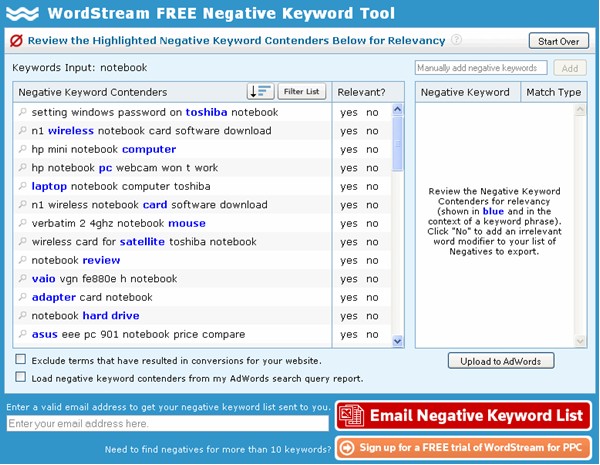What Are Negative Keywords?
Negative keywords are a core component of a successful Pay-per-click ad campaign. Adding a negative keyword to your ad group or campaign means that your ads won’t show for searches containing that term. By filtering out unwanted impressions, negative keywords can help you reach the most appropriate prospects, reduce your cost-per-click (CPC), and increase your ROI.
Here’s an example:
The negative keyword “–free trial” would prevent your ads from showing on any searches containing the terms free and trial. It wouldn’t prevent your ads from showing on variations of these terms, however. It also wouldn’t prevent your ads from showing on searches that only contain one of the terms.
For instance, the search terms one-day trial and free test could trigger your ads, while free one-day trial could not.
In another example, if you’re selling clothes, but you don’t sell shorts, you can make ‘shorts’ a negative keyword. That way you won’t show your ad to a shopper looking for shorts (which may help you save money).
Some advertisers are nervous about using negative keywords because they fear it will reduce the traffic to their sites. If your goal is simply to increase traffic, then you may not want to use negative keywords. But if your goal is to find qualified leads, negative keywords will help filter out some of the traffic that you may not want. You can learn more about how to choose negative keywords here.
Three Ways To Find Yours
1. Your Web Analytics
Some people come up with negative keywords by brainstorming. For example, if you sell baseball caps, your starter list of negative keyword candidates might include “cap gun” and “small cap fund.“
A better way to catch those unrelated terms is to look through your Web analytics. Even if you haven’t started doing PPC yet, your organic-keyword reports are a good source of negative-keyword candidates. To find your keyword referrers in Google Analytics, go to “Traffic Sources,” then “Keywords.”
There you can scan through the keywords that are driving search-engine traffic to your site. Look for terms that aren’t relevant to your business; those are the ones you wouldn’t want to bid on.
2. Search-Query Reports
Similarly, you can look at reports of the search queries that led to impressions and clicks of your PPC ads. That is a slightly more direct way of finding negative keywords, because you know for a fact that your ads are matching against those queries. Google AdWords Help offers a quick tutorial on setting up a Search Query Performance report in AdWords.
Approach your search-query reports the same way you approached your organic-keyword reports. Look for queries that triggered your ads but don’t relate to what the ad was actually offering.
For example, if you offer Web-design services and a query about interior design triggers your information-architecture ad, you might want to set “interior” as a negative keyword.
3. A Free Negative-Keyword Tool
A third way to find negative keywords is to use the Free Negative Keyword Tool from WordStream. The tool provides a direct way to find negative-keyword candidates because it identifies entire clusters of keywords you might want to filter, rather than single instances.
To use the tool, just enter a keyword that you might want to bid on. Let’s say you sell notebooks—as in old-school spiral notebooks, not notebook computers. Enter the word “notebook” to get a list of negative-keyword suggestions.
As you can see in the graphic, most of the keywords have to do with notebook computers. If you see a term that isn’t relevant (such as “toshiba,” “wireless,” “computer,” “pc,” and “laptop”), you can click “no” to add it to the list of negative keywords.
The tool marks as negative all the keyword suggestions that contain “toshiba,” not just the term you mark, so the process is much more efficient than sorting through a search-query report.
The tool also suggests related negative terms to save you time. But if you see a term that is relevant, such as “notebook paper,” you can keep it off the list of negatives.
Once you’re satisfied with your list, you can upload it to AdWords directly or email it to yourself in spreadsheet format.
To give this tool a try, click here (in center of page).
Content for this article excerpted from Google Adwords Blog and Larry Kim, founder of Wordstream.com

